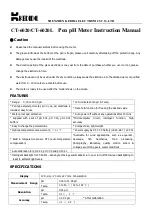
Model 4200A-SCS Parameter Analyzer Reference Manual
Section 12: Maintenance
4200A-901-01 Rev. C / February 2017
12-13
Figure 496: External offset current
Triboelectric effects
Triboelectric currents are generated by charges created by friction between a conductor and an
insulator. Free electrons rub off the conductor and create a charge imbalance that causes the current
flow.
The triaxial cables supplied with the SMU and preamplifier greatly reduce this effect by using
graphite-impregnated insulation underneath the outer shield. The graphite provides lubrication and a
conducting cylinder to equalize and minimize charges generated by frictional effects of cable
movement. However, even this type of triaxial cable creates some noise when subjected to vibration
and expansion or contraction. Therefore, all connections should be kept short, away from
temperature changes (which can create thermal expansion forces), and supported by taping or wiring
the cable to a non-vibrating surface such as a wall, bench, or rigid structure.
Other solutions to movement and vibration problems include:
•
Remove or mechanically decouple vibration sources such as motors, pumps, and other
electromechanical devices.
•
Securely mount or tie down electronic components, wires, and cables.
•
Mount the preamplifier as close as possible to the DUT.
A temporary triboelectric current is generated when a triaxial cable is first connected. This current is
typically tens or hundreds of femtoamperes and can last as long as 5 to 10 minutes.
Piezoelectric and stored charge effects
Piezoelectric currents are generated when mechanical stress is applied to certain crystalline materials
used for insulated terminals and interconnecting hardware. In some plastics, pockets of stored charge
cause the material to behave in a manner similar to piezoelectric materials.
To minimize the current due to this effect, remove mechanical stresses from the insulator, and use
insulating materials such as polyethylene that have minimal piezoelectric and stored charge effects.
Do not bend cables to make tight corners. Do not let long cables hang. Lay all cables on a flat
surface.
















































